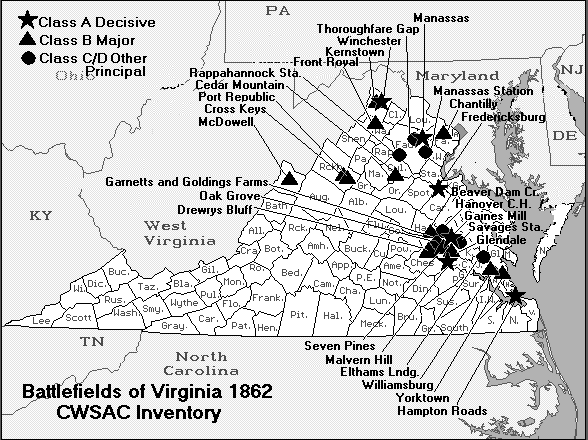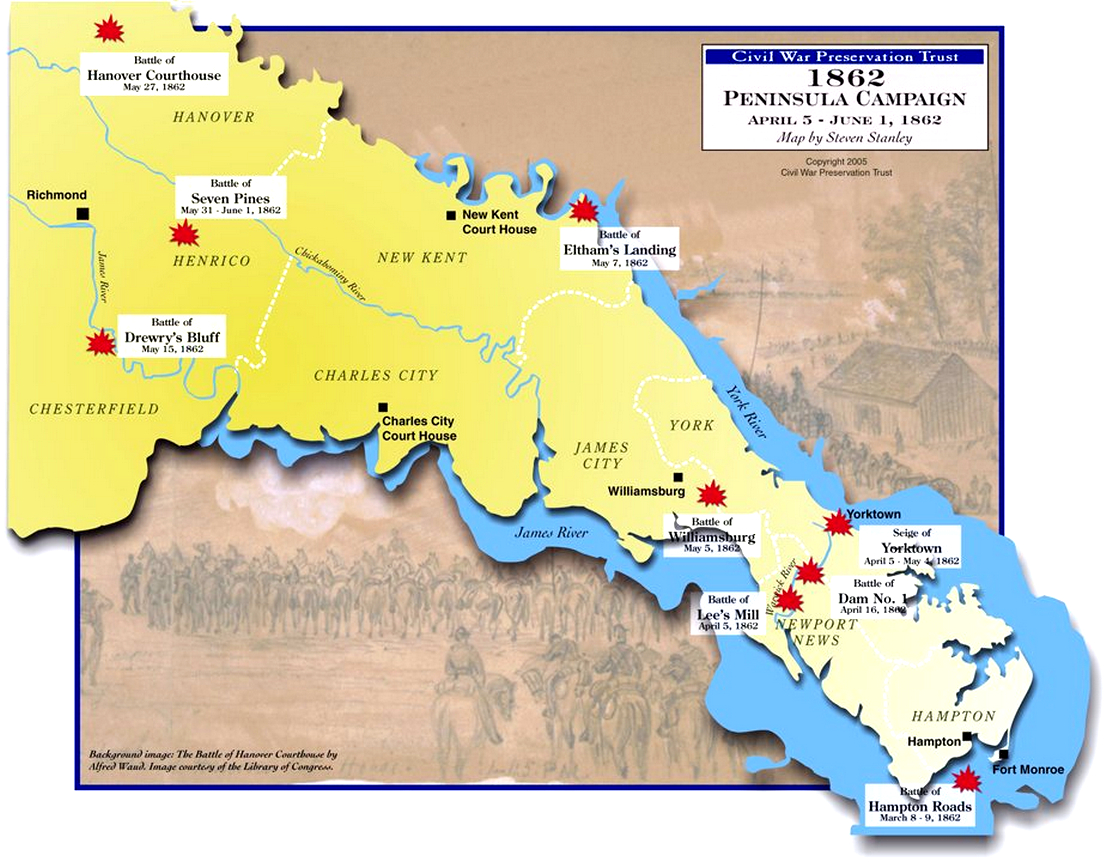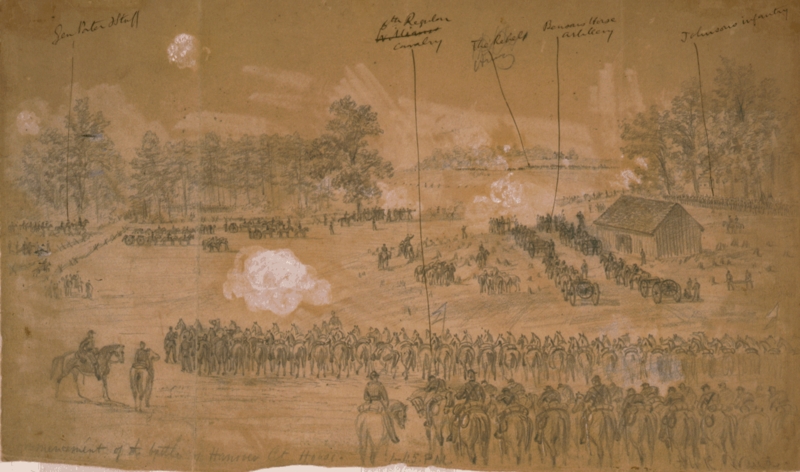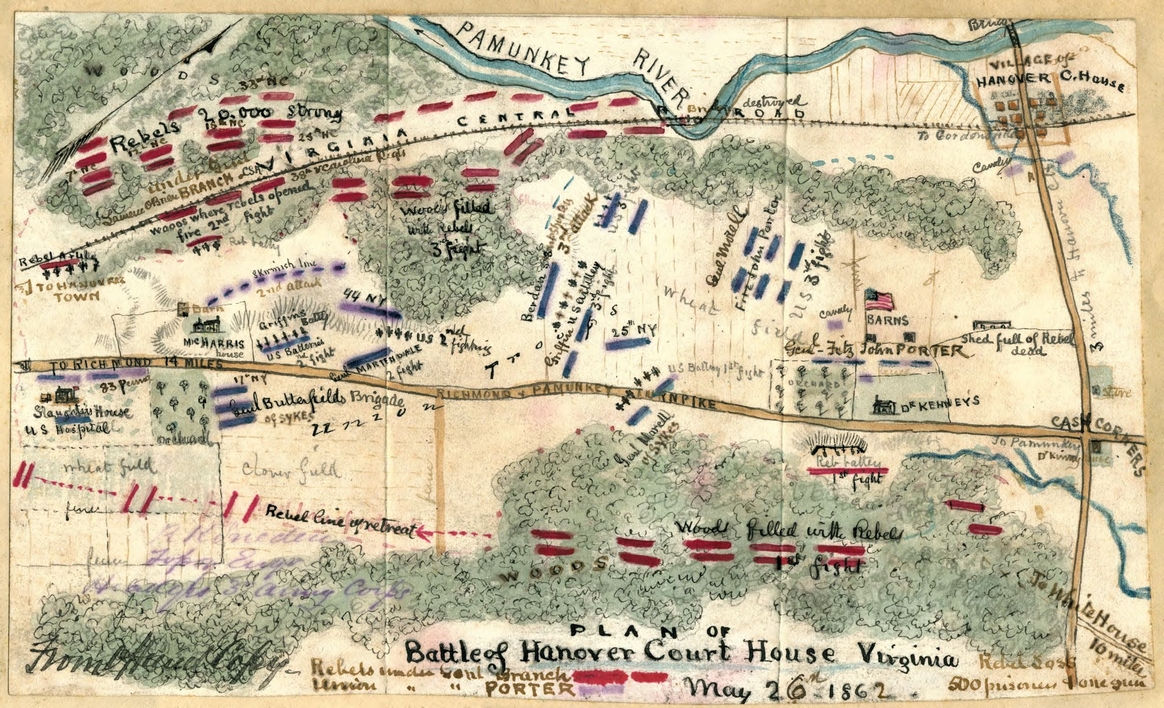|
Battle of Hanover Court House
Hanover Court House Civil War History
Hanover Court House, Virginia
Other Names: Slash Church, Lebanon Church
Location: Hanover County
Campaign: Peninsula Campaign (March-July 1862)
Date(s): May 27, 1862
Principal Commanders: Brig. Gen. Fitz John Porter [US]; Brig.
Gen. Lawrence O'B. Branch [CS]
Forces Engaged: Divisions
Estimated Casualties: 1,327 total (US 397; CS 930)
Result(s): Union victory
| Battle of Hanover Courthouse Map |

|
| Civil War Battle of Hanover Court House Battlefield Map |
Summary: On May 27, 1862, elements of Brig. Gen. Fitz John Porter’s
V Corps extended north to protect the right flank of McClellan’s Union army that now straddled the Chickahominy River.
Porter’s objective was to cut the railroad and to open the Telegraph Road for Union reinforcements under Maj. Gen. Irvin
McDowell that were marching south from Fredericksburg. Confederate forces, attempting to prevent this maneuver, were
defeated just south of Hanover Courthouse after a stiff fight. The Union victory was moot, however, for McDowell’s reinforcements
were recalled to Fredericksburg upon word of Banks’s rout at First Winchester. At Hanover Court House, Union forces
numbered approximately 12,000, while Confederate forces were approximately 4,000.
Background: Confederate General Joseph E. Johnston
withdrew his 60,000-man army from the Virginia Peninsula as McClellan's army pursued him and approached the Confederate capital
of Richmond. Johnston's defensive line began at the James River at Drewry's Bluff, site of the recent Confederate naval victory,
and extended counterclockwise so that his center and left were behind the Chickahominy River, a natural barrier in the spring
when it turned the broad plains to the east of Richmond into swamps. Johnston's men burned most of the bridges over the Chickahominy
and settled into strong defensive positions north and east of the city. McClellan positioned his 105,000-man army to focus
on the northeast sector, for two reasons. First, the Pamunkey River, which ran roughly parallel to the Chickahominy, offered
a line of communication that could enable McClellan to get around Johnston's left flank. Second, McClellan anticipated the
arrival of the I Corps under Maj. Gen. Irwin McDowell, scheduled to march south from Fredericksburg to reinforce his army,
and thus needed to protect their avenue of approach.
The Army of the Potomac pushed slowly up the Pamunkey, establishing supply
bases at Eltham's Landing, Cumberland Landing, and White House Landing. White House, the plantation of W.H.F. "Rooney" Lee,
son of General Robert E. Lee, became McClellan's base of operations. Using the Richmond and York River Railroad, McClellan
could bring his heavy siege artillery to the outskirts of Richmond. He moved slowly and deliberately, reacting to faulty intelligence
that led him to believe the Confederates outnumbered him significantly. By the end of May, the army had built bridges across
the Chickahominy and was facing Richmond, straddling the river, with one third of the Army south of the river, two thirds
north. (This disposition, which made it difficult for one part of the army to reinforce the other quickly, would prove to
be a significant problem in the upcoming Battle of Seven Pines).
While skirmishing occurred all along the line between the armies, McClellan
heard a rumor from a Virginia civilian that a Confederate force of 17,000 was moving to Hanover Court House, north of Mechanicsville.
If this were true, it would threaten the army's right flank and complicate the arrival of McDowell's reinforcements. A Union
cavalry reconnaissance adjusted the estimate of the enemy strength to be 6,000, but it was still cause for concern. McClellan
ordered his close friend, Maj. Gen. Fitz John Porter, commander of the newly formed V Corps, to deal with the threat.
Porter departed on his mission at 4 a.m. on May 27 with his 1st Division,
under Brig. Gen. George W. Morell, the 3rd Brigade of Brig. Gen. George Sykes's 2nd Division, under Colonel Gouverneur K.
Warren, and a composite brigade of cavalry and artillery led by Brig. Gen. William H. Emory, altogether about 12,000 men.
The Confederate force, which actually numbered about 4,000 men, was led by Col. Lawrence O'Bryan Branch, and included the
18th, 28th, and 37th North Carolina Infantry regiments, and the 45th Georgia Infantry. They had departed from Gordonsville
to guard the Virginia Central Railroad, taking up position at Peake's Crossing, 4 miles outhwest of the courthouse, near Slash
Church. Another Confederate brigade was stationed 10 miles north at Hanover Junction.
| Battle of Hanover Court House |

|
| Battle of Hanover Court House and Peninsula Campaign |
| Battle of Hanover Courthouse |

|
| Civil War Battle of Hanover Court House |
Battle: The Battle of Slash Church, as it was also known,
was contested near Hanover Court House, Virginia, on the 27th of May 1862.
For the Southerners, with the exception of one regiment, it was purely a North Carolina fight.
(Right) Commencement of the battle of Hanover Ct. House. 1:45 PM. Alfred R. Waud, artist, May 27, 1862.
Library of Congress.
Porter's men approached Peake's Crossing in a driving rain. At about noon
on May 27, his lead element, the 25th New York Infantry, encountered Col. James H. Lane's 28th North Carolina on a reconnaissance
patrol at the farm owned by Dr. Thomas H. Kinney. The New Yorkers, along with the 1st U.S. Sharpshooters, skirmished briskly
with the Confederates until Porter's main body arrived, driving the outnumbered Rebels up the road in the direction of the
courthouse. Porter set out in pursuit with most of his force, leaving three regiments (the 2nd Maine, the 44th New York, and
the damaged 25th New York), under the command of Brig. Gen. John H. Martindale, to guard the New Bridge and Hanover Court
House Roads intersection, a mile to the west of Kinney's farm. This movement exposed the rear of Porter's command to attack
by the bulk of Branch's force, which Porter had mistakenly assumed was at Hanover Court House.
Branch also made a poor assumption—that Porter's force was significantly
smaller than it turned out to be—and attacked. Col. Charles C. Lee led his own regiment, the 37th North Carolina, along
with the 18th North Carolina and two cannons from Latham's Battery. An initial assault by the 18th was repulsed, but when
the 37th joined in, Martindale's force was almost destroyed by the heavy fire. The 44th New York suffered 25% casualties and
its battle flag received 44 bullet holes.
When messengers reached Porter with news of the engagement, he quickly dispatched
the 9th Massachusetts and 62nd Pennsylvania regiments back to the Kinney Farm. The Confederate line broke under the weight
of thousands of new troops and they retreated back through Peake's Crossing to Ashland.
| Battle of Hanover Court House |

|
| Hanover Court House Battlefield |
Casualties: Estimates for Union casualties vary,
from 355 (62 killed, 233 wounded, 70 captured) to 397. The Confederates left 200 dead and wounded on the field and 730 were
captured by Porter's cavalry. Whereas the combined casualty figures were generally estimated at some 1,300 troops,
the following figures were taken from Fox's Regimental Losses and Dyer's Compendium. The lack of missing and captured
numbers reported by the Confederates make it difficult to ascertain a more accurate casualty total.
| Regiment |
Date |
Killed |
Wounded |
POW |
Missing |
Losses |
|
|
| 9th Massachusetts Infantry Regiment |
May 27 1862 |
1 |
4 |
1 |
0 |
6 |
|
|
| 3rd Massachusetts Light Artillery |
May 27 1862 |
0 |
1 |
0 |
0 |
1 |
|
|
| 2nd Maine Infantry Regiment |
May 27 1862 |
4 |
18 |
0 |
0 |
22 |
|
|
| 16th Michigan Infantry Regiment |
May 27 1862 |
0 |
2 |
3 |
0 |
5 |
|
|
| 2nd Minnesota Sharpshooters Company |
May 27 1862 |
0 |
2 |
0 |
0 |
2 |
|
|
| 12th New York Infantry Regiment |
May 27 1862 |
0 |
1 |
0 |
0 |
1 |
|
|
| 13th New York Infantry Regiment |
May 27 1862 |
0 |
2 |
0 |
0 |
2 |
|
|
| 25th New York Infantry Regiment |
May 27 1862 |
22 |
78 |
63 |
0 |
163 |
|
|
| 44th New York Infantry Regiment |
May 27 1862 |
25 |
62 |
0 |
1 |
88 |
|
|
| 62nd Pennsylvania Infantry Regiment |
May 27 1862 |
0 |
3 |
0 |
0 |
3 |
|
|
| 83rd Pennsylvania Infantry Regiment |
May 27 1862 |
0 |
7 |
0 |
0 |
7 |
|
|
| 1st U.S. Sharpshooters Volunteers Regiment |
May 27 1862 |
0 |
8 |
0 |
0 |
8 |
|
|
| Co. H 3rd North Carolina Light Artillery Battery |
May 27 1862 |
0 |
5 |
12 |
0 |
17 |
|
|
| 2nd North Carolina Infantry Regiment |
May 27 1862 |
0 |
0 |
4 |
0 |
4 |
|
|
| 7th North Carolina Infantry Regiment |
May 27 1862 |
1 |
7 |
15 |
0 |
23 |
|
|
| 12th North Carolina Infantry Regiment |
May 27 1862 |
3 |
13 |
22 |
0 |
38 |
|
|
| 18th North Carolina Infantry Regiment |
May 27 1862 |
23 |
84 |
100 |
0 |
207 |
|
|
| 20th North Carolina Infantry Regiment |
May 27 1862 |
0 |
0 |
1 |
0 |
1 |
|
|
| 26th North Carolina Infantry Regiment |
May 27 1862 |
0 |
0 |
1 |
0 |
1 |
|
|
| 28th North Carolina Infantry Regiment |
May 27 1862 |
8 |
14 |
263 |
0 |
285 |
|
|
| 33rd North Carolina Infantry Regiment |
May 27 1862 |
0 |
3 |
21 |
0 |
24 |
|
|
| 37th North Carolina Infantry Regiment |
May 27 1862 |
26 |
67 |
151 |
0 |
244 |
|
|
| 4th Virginia Cavalry Regiment |
May 27 1862 |
0 |
1 |
2 |
0 |
3 |
|
|
| 12th South Carolina Infantry Regiment |
May 27 1862 |
0 |
1 |
0 |
0 |
1 |
Analysis: The Battle of Hanover Court House, also known
as the Battle of Slash Church, took place on May 27, 1862, in Hanover County, Virginia, as part of the Peninsula Campaign
of the American Civil War. On May 27, elements of Brig. Gen. Fitz John
Porter's V Corps extended north to protect the right flank of Maj. Gen. George B. McClellan's Union Army of the Potomac. Porter's
objective was to deal with a Confederate force near Hanover Court House, which threatened the avenue of approach for Union
reinforcements that were marching south from Fredericksburg. The smaller Confederate force, under Colonel Lawrence O'Bryan
Branch, was defeated at Peake's Crossing after a disorganized fight. The Union victory was moot, however, for the Union reinforcements
were recalled to Fredericksburg upon word of Maj. Gen. Nathaniel P. Banks's rout in the Shenandoah Valley at First Winchester.
Sources: National Park Service; Official Records of the Union and Confederate Armies.
Recommended
Reading:
Battle
of Hanover Court House: Turning Point of the Peninsula Campaign,
May 27, 1862 (Hardcover). Description: Researched from official reports
as well as contemporary accounts, this is the first detailed look at the battle most widely known as Hanover Court House and Slash Church. The opening chapters
set the stage for this crucial battle and outline the events that led up to May 27, 1862, and the high tide of the Peninsula
Campaign. Continued below...
The book’s main focus is the series of battles that took place between the forces of Union V Corps
commander Fitz John Porter and Confederate general Lawrence O’Bryan Branch. Photographs of the battle's central participants
are included, along with appendices featuring the official reports of commanders and lists of casualties from both sides.
Sources: National Park Service; Civil War Trust, civilwar.org; Library of
Congress; National Archives; Eicher, David J. The Longest Night: A Military History of the Civil War. New York: Simon &
Schuster, 2001. ISBN 0-684-84944-5; Kennedy, Frances H., ed. The Civil War Battlefield Guide. 2nd ed. Boston: Houghton Mifflin
Co., 1998. ISBN 0-395-74012-6; Salmon, John S. The Official Virginia Civil War Battlefield Guide. Mechanicsburg, PA: Stackpole
Books, 2001. ISBN 0-8117-2868-4; Sears, Stephen W. To the Gates of Richmond: The Peninsula Campaign. Ticknor and Fields, 1992.
ISBN 0-89919-790-6; Burton, Brian K. (2007). The Peninsula & Seven Days: A Battlefield Guide. Lincoln: University of Nebraska
Press. ISBN 978-0-8032-6246-1; Gallagher, Gary W., ed. (2000). The Richmond Campaign of 1862: The Peninsula & the Seven
Days. Chapel Hill: University of North Carolina Press. ISBN 0-8078-2552-2; Hardy, Michael (2006). The Battle of Hanover Court
House: Turning Point of the Peninsula Campaign, May 27, 1862. Jefferson, NC: McFarland & Co. ISBN 978-0-7864-2464-1; Martin,
David G. (1992). The Peninsula Campaign March–July 1862. Conshohocken, PA: Combined Books. ISBN 978-0-938289-09-8.
|

